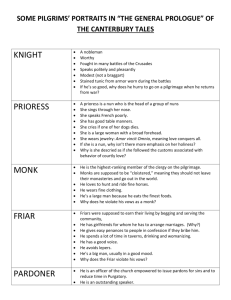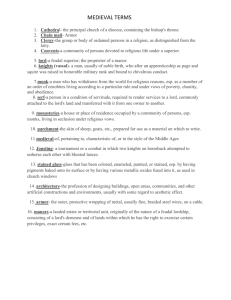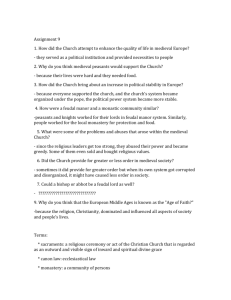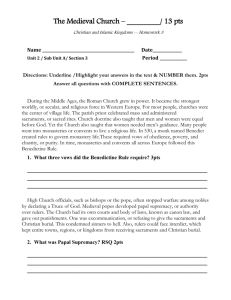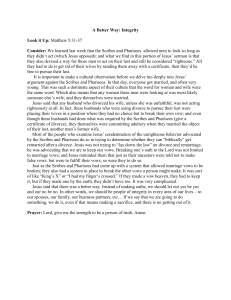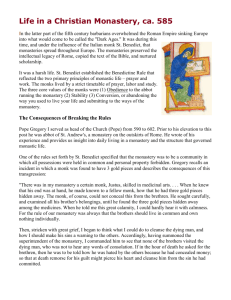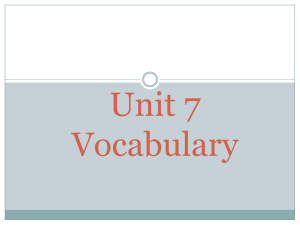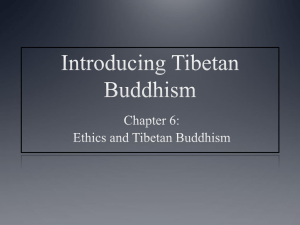2-10 November 2007 Solemn Profession
advertisement
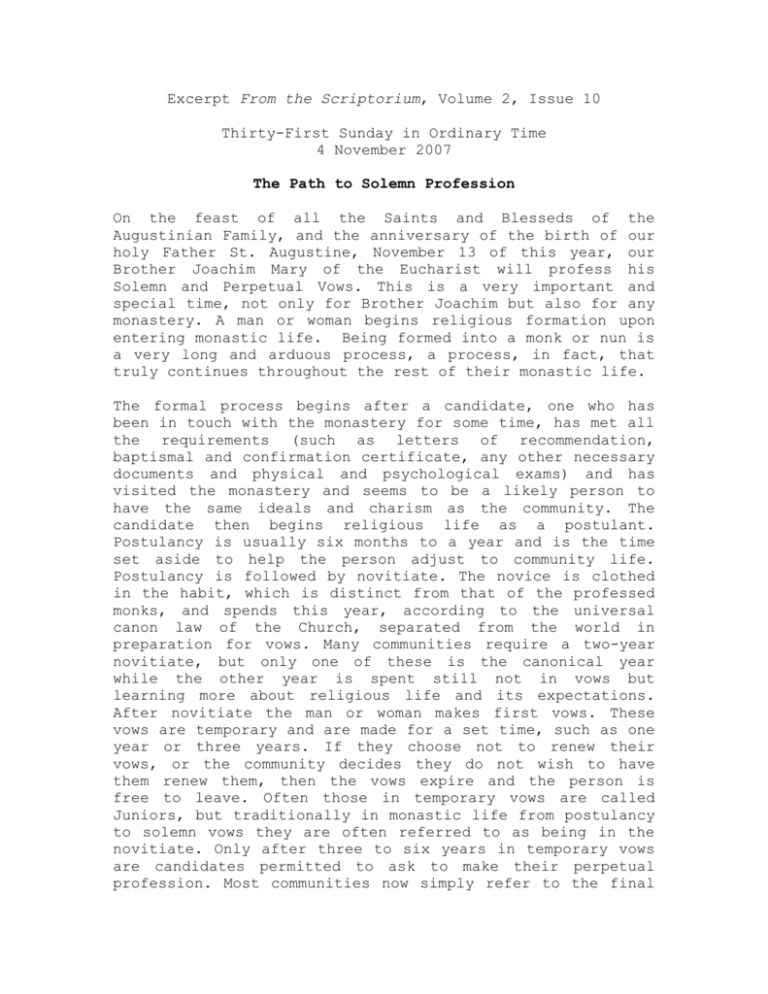
Excerpt From the Scriptorium, Volume 2, Issue 10 Thirty-First Sunday in Ordinary Time 4 November 2007 The Path to Solemn Profession On the feast of all the Saints and Blesseds of the Augustinian Family, and the anniversary of the birth of our holy Father St. Augustine, November 13 of this year, our Brother Joachim Mary of the Eucharist will profess his Solemn and Perpetual Vows. This is a very important and special time, not only for Brother Joachim but also for any monastery. A man or woman begins religious formation upon entering monastic life. Being formed into a monk or nun is a very long and arduous process, a process, in fact, that truly continues throughout the rest of their monastic life. The formal process begins after a candidate, one who has been in touch with the monastery for some time, has met all the requirements (such as letters of recommendation, baptismal and confirmation certificate, any other necessary documents and physical and psychological exams) and has visited the monastery and seems to be a likely person to have the same ideals and charism as the community. The candidate then begins religious life as a postulant. Postulancy is usually six months to a year and is the time set aside to help the person adjust to community life. Postulancy is followed by novitiate. The novice is clothed in the habit, which is distinct from that of the professed monks, and spends this year, according to the universal canon law of the Church, separated from the world in preparation for vows. Many communities require a two-year novitiate, but only one of these is the canonical year while the other year is spent still not in vows but learning more about religious life and its expectations. After novitiate the man or woman makes first vows. These vows are temporary and are made for a set time, such as one year or three years. If they choose not to renew their vows, or the community decides they do not wish to have them renew them, then the vows expire and the person is free to leave. Often those in temporary vows are called Juniors, but traditionally in monastic life from postulancy to solemn vows they are often referred to as being in the novitiate. Only after three to six years in temporary vows are candidates permitted to ask to make their perpetual profession. Most communities now simply refer to the final vows as perpetual, but in the oldest communities in the Church’s history, such as Augustinian, Benedictine, Trinitarian, Carmelite, Dominican, Franciscan and Visitation, monks and nuns make solemn vows. According to the code of canon law of 1983, it is the Constitutions of each community that determine if the vows are to be solemn. At the present time in the Church, the use of the term ‘solemn’ vows mainly refers to the vow of poverty, the distinction being that the man or woman after making the solemn vows owns and will own nothing in their lifetime. According to the Constitutions of the Augustinian Monks of the Primitive Observance, the novitiate for a man is one year. Brother Joachim has been with us since 2002, entering our Monastery on Peaks Island, Maine, where as a postulant and then a novice he began his religious formation. On November 9, 2003, just seven weeks before our move to DeLand, he made his temporary vows. Now after four years as a Junior and after petitioning the solemnly professed and receiving the vote of acceptance, he will make his solemn and perpetual vows on November 13, the feast of all the Saints and Blesseds of the Augustinian Family, and the anniversary of the birth of our holy Father St. Augustine, who was born in 354. The rite of Solemn Profession is a very ancient rite in the Church. Properly speaking, it takes place during the Holy Sacrifice of the Mass; since the monk or nun is making an offering of themselves, it is right that it should be united with the sacrifice of Jesus Christ. Mass begins in the usual way, and the candidate for solemn vows walks in as part of the entrance procession. After the opening rite, the collect and the proclamation of the readings, the Abbot takes his place in front of the altar and asks the candidate “What do you ask of the Lord and His Church?” The candidate requests solemn vows, and the Abbot publicly declares the permission to make them. The homily follows, and then the Abbot interrogates the monk, asking if he is willing to live the monastic life, to profess the vows of chastity, poverty and obedience and to live in solitude and silence for the glory of God and the salvation of souls. After the man has made his intentions known, the Abbot prays for the help of the Lord and then all kneel. The passing bell, signaling death, begins to toll while the candidate prostrates himself on the floor. A pious custom, handed down through the ages, is that monks or nuns who are to make profession may carry upon themselves petitions people have written out on slips of paper. According to this pious devotion, the Lord will grant whatever one asks of Him at this time of dying to the world. Brother Joachim will be covered with the funeral pall, denoting his death to this world, while the litany of the Saints is chanted. At the conclusion of the litany all rise, and the celebrant prays for the man about to make his solemn vows. The Abbot is then seated and holds in his hands the holy Rule of St. Augustine. The candidate steps forward and kneels before the Abbot, placing his right hand on the holy Rule. Two witnesses flank him with lit candles, and Brother in a clear voice pronounces the formula of profession. The Abbot accepts the vows and says during the acceptance, “…and we affiliate you to Mother of the Good Shepherd Monastery.” This simple statement grants Brother stability in the Monastery. Unlike members of active communities, monks and nuns do not move from house to house but rather spend their entire life in one monastery. Brother Joachim after solemn vows will remain at Mother of the Good Shepherd Monastery for the rest of his life. After the profession of vows, the newly professed monk proceeds to the altar, where the book of vows has been placed ahead of time. The book of vows contains, written out, all the vows that have been professed from the time of foundation. In some monasteries, such as the Visitation Monastery in Washington D. C., the book is several hundred years old. The newly professed monk signs his vows, which he has written by hand before the ceremony, and the two witnesses and the Abbot also sign the book. Brother Joachim will then proceed to the lit Paschal candle. The same Paschal candle that was blessed and lit on Easter, that stood in the sanctuary during the Easter season, and is always lit for baptisms and funerals, now stands as a symbol not only of Christ’s resurrection but also of Brother Joachim’s death to this world and his rising to his new monastic life in Christ. He will take a candle that his parents have provided, light it from the Paschal candle and holding it sing the Suscipe, an ancient monastic hymn of praise taken from the psalms, a hymn of self-offering and of acclamation. In the Augustinian tradition it is united with the prayer of our Holy Father St. Augustine, “You alone do I love.” At the conclusion of the Suscipe, the Abbot will pray over Brother Joachim the Roman Rite prayer of consecration, thereby consecrating Brother Joachim’s monastic life to the Lord forever. Then comes the blessing of the cowl. In monastic life the choir cowl is worn by the solemnly professed at the celebration of Mass, during the divine office and at other liturgical and formal celebrations. Each monastic tradition has its own cut and design for the choir cowl. Augustinians always emphasize their full sleeves—in fact, the Augustinian Friars used to don large sleeves under their capuche rather than wearing a full cowl. When Brother Joachim was clothed as a novice, he received the choir cloak or mantle; this will now be removed, and he will be clothed with the cowl marking him as a solemnly professed monk. Brother will then be given the gold ring as a sign of his total union with the Lord Jesus, after which he will be presented with a book of the liturgy of the Hours and thus be commissioned to take his place as a contemplative in the Church, spending the rest of his earthly life praising God and interceding for the Lord’s faithful. After the symbols are given, the Abbot, along with Brother Nicholas and the two oblate priests of the Monastery, will welcome Brother Joachim as a chapter monk. A chapter monk, or a capitular, is a solemnly professed monk, and as such enjoys the full rights and privileges of a perpetually professed.

